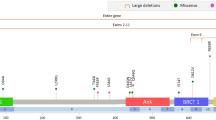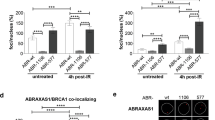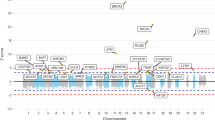Abstract
Breast cancer is a heterogeneous disease displaying some degree of familial clustering. Highly penetrant breast cancer susceptibility genes represent approximately 20–25% of the familial aggregation of breast cancer. A significant proportion of this familial aggregation of breast cancer is thus yet to be explained by other breast cancer susceptibility genes. Given the high susceptibility conferred by the two major breast cancer predisposition genes, BRCA1 and BRCA2 and the implication of these genes in many key cellular processes, assessment of genes encoding BRCA1-interacting proteins as plausible breast cancer candidate genes is thus attractive. In this study, four genes encoding BRCA1-interacting proteins were analyzed in a cohort of 96 breast cancer individuals from high-risk non-BRCA1/BRCA2 French Canadian families. Although no deleterious truncating germline mutations or aberrant spliced mRNA species were identified, a total of 10, 4, 11 and 6 variants were found in the AURKA, BAP1, BARD1 and DHX9 genes, respectively. The allele frequency of each variant was further ascertained in a cohort of 98 healthy French Canadian unrelated women and a difference in allele frequency was observed for one BARD1 variant based on single-marker analysis. Haplotype estimation, haplotype blocks and tagging SNPs identification were then performed for each gene, providing a valuable tool for further searches of common disease-associated variants in these genes and therefore further analyses on these genes in larger cohorts is warranted in the search of low-to-moderate penetrance breast cancer susceptibility alleles.
Similar content being viewed by others
Log in or create a free account to read this content
Gain free access to this article, as well as selected content from this journal and more on nature.com
or
Accession codes
References
Bradbury, A. R. & Olopade, O. I. Genetic susceptibility to breast cancer. Rev. Endocr. Metab. Disord. 8, 255–267 (2007).
Easton, D. F. How many more breast cancer predisposition genes are there? Breast Cancer Res. 1, 14–17 (1999).
Stratton, M. R. & Rahman, N. The emerging landscape of breast cancer susceptibility. Nat. Genet. 40, 17–22 (2008).
Simard, J., Dumont, M., Moisan, A. M., Gaborieau, V., Malouin, H., Durocher, F. et al. Evaluation of BRCA1 and BRCA2 mutation prevalence, risk prediction models and a multistep testing approach in French-Canadian families with high risk of breast and ovarian cancer. J. Med. Genet. 44, 107–121 (2007).
Durocher, F., Labrie, Y., Soucy, P., Sinilnikova, O., Labuda, D., Bessette, P. et al. Mutation analysis and characterization of ATR sequence variants in breast cancer cases from high-risk French Canadian breast/ovarian cancer families. BMC Cancer 6, 230 (2006).
Durocher, F., Labrie, Y., Ouellette, G., INHERIT BRCAs & Simard, J. Genetic sequence variations and ADPRT haplotype analysis in French Canadian families with high risk of breast cancer. J. Hum. Genet. 52, 963–977 (2007).
Guénard, F., Labrie, Y., Ouellette, G., Beauparlant, C. J., Bessette, P., Chiquette, J. et al. Germline mutations in the breast cancer susceptibility gene PTEN are rare in high-risk non-BRCA1/2 French Canadian breast cancer families. Fam. Cancer 6, 483–490 (2007).
Guénard, F., Labrie, Y., Ouellette, G., Joly Beauparlant, C., Simard, J., INHERIT BRCAs & Durocher, F. Mutational analysis of the breast cancer susceptibility gene BRIP1/BACH1/FANCJ in high-risk non-BRCA1/BRCA2 breast cancer families. J. Hum. Genet. 53, 579–591 (2008).
Desjardins, S., Belleau, P., Labrie, Y., Ouellette, G., Bessette, P., Chiquette, J. et al. Genetic variants and haplotype analyses of the ZBRK1/ZNF350 gene in high-risk non BRCA1/2 French Canadian breast and ovarian cancer families. Int. J. Cancer 122, 108–116 (2008a).
Desjardins, S., Ouellette, G., Labrie, Y., Simard, J., INHERIT BRCAs & Durocher, F. Analysis of GADD45A sequence variations in French Canadian families with high risk of breast cancer. J. Hum. Genet. 53, 490–498 (2008b).
Scully, R., Anderson, S. F., Chao, D. M., Wei, W., Ye, L., Young, R. A. et al. BRCA1 is a component of the RNA polymerase II holoenzyme. Proc. Natl. Acad. Sci. USA 94, 5605–5610 (1997).
Durocher, F., Guénard, F., Desjardins, S., Ouellette, G. & Labrie, Y. Inherited susceptibility to breast cancer: accomplishments and challenges. In: Sinnett D (ed). Molecular genetics of cancer Research Signpost, Kerala, pp 19–93 (2005).
Antoniou, A. C. & Easton, D. Polygenic inheritance of breast cancer: Implications for design of association studies. Genet. Epidemiol. 25, 190–202 (2003).
Zhou, H., Kuang, J., Zhong, L., Kuo, W. L., Gray, J. W., Sahin, A. et al. Tumour amplified kinase STK15/BTAK induces centrosome amplification, aneuploidy and transformation. Nat. Genet. 20, 189–193 (1998).
Dutertre, S., Descamps, S. & Prigent, C. On the role of aurora-A in centrosome function. Oncogene 21, 6175–6183 (2002).
Ouchi, M., Fujiuchi, N., Sasai, K., Katayama, H., Minamishima, Y. A., Ongusaha, P. P. et al. BRCA1 phosphorylation by Aurora-A in the regulation of G2 to M transition. J. Biol. Chem. 279, 19643–19648 (2004).
Ewart-Toland, A., Briassouli, P., de Koning, J. P., Mao, J. H., Yuan, J., Chan, F. et al. Identification of Stk6/STK15 as a candidate low-penetrance tumor-susceptibility gene in mouse and human. Nat. Genet. 34, 403–412 (2003).
Dai, Q., Cai, Q. Y., Shu, X. O., Ewart-Toland, A., Wen, W. Q., Balmain, A. et al. Synergistic effects of STK15 gene polymorphisms and endogenous estrogen exposure in the risk of breast cancer. Cancer Epidemiol. Biomarkers Prev. 13, 2065–2070 (2004).
Egan, K. M., Newcomb, P. A., Ambrosone, C. B., Trentham-Dietz, A., Titus-Ernstoff, L., Hampton, J. M. et al. STK15 polymorphism and breast cancer risk in a population-based study. Carcinogenesis 25(11):2149-2153. Erratum in: Carcinogenesis 26, 701 (2004).
Sun, T., Miao, X., Wang, J., Tan, W., Zhou, Y., Yu, C. et al. Functional Phe31Ile polymorphism in Aurora A and risk of breast carcinoma. Carcinogenesis 25, 2225–2230 (2004).
Ewart-Toland, A., Dai, Q., Gao, Y. T., Nagase, H., Dunlop, M. G., Farrington, S. M. et al. Aurora-A/STK15 T+91A is a general low penetrance cancer susceptibility gene: a meta-analysis of multiple cancer types. Carcinogenesis 26, 1368–1373 (2005).
Lo, Y. L., Yu, J. C., Chen, S. T., Yang, H. C., Fann, C. S., Mau, Y. C. et al. Breast cancer risk associated with genotypic polymorphism of the mitosis-regulating gene Aurora-A/STK15/BTAK. Int. J. Cancer 115, 276–283 (2005).
Cox, D. G., Hankinson, S. E. & Hunter, D. J. Polymorphisms of the AURKA (STK15/Aurora Kinase) Gene and Breast Cancer Risk (United States). Cancer Causes Control. 17, 81–83 (2006).
Fletcher, O., Johnson, N., Palles, C., dos Santos Silva, I., McCormack, V., Whittaker, J. et al. Inconsistent association between the STK15 F31I genetic polymorphism and breast cancer risk. J. Natl. Cancer Inst. 98, 1014–1018 (2006).
Couch, F. J., Sinilnikova, O., Vierkant, R. A., Pankratz, V. S., Fredericksen, Z. S., Stoppa-Lyonnet, D. et al. AURKA F31I polymorphism and breast cancer risk in BRCA1 and BRCA2 mutation carriers: a consortium of investigators of modifiers of BRCA1/2 study. Cancer Epidemiol. Biomarkers Prev. 16, 1416–1421 (2007).
Tchatchou, S., Wirtenberger, M., Hemminki, K., Sutter, C., Meindl, A., Wappenschmidt, B. et al. Aurora kinases A and B and familial breast cancer risk. Cancer Lett. 247, 266–272 (2007).
Vidarsdottir, L., Bodvarsdottir, S. K., Hilmarsdottir, H., Tryggvadottir, L. & Eyfjord, J. E. Breast cancer risk associated with AURKA 91T -->A polymorphism in relation to BRCA mutations. Cancer Lett. 250, 206–212 (2007).
Jensen, D. E., Proctor, M., Marquis, S. T., Gardner, H. P., Ha, S. I., Chodosh, L. A. et al. BAP1: a novel ubiquitin hydrolase which binds to the BRCA1 RING finger and enhances BRCA1-mediated cell growth suppression. Oncogene 16, 1097–1112 (1998).
Jensen, D. E. & Rauscher, F. J. III. BAP1, a candidate tumor suppressor protein that interacts with BRCA1. Ann. NY Acad. Sci. 886, 191–194 (1999).
Hu, J. J., Mohrenweiser, H. W., Bell, D. A., Leadon, S. A. & Miller, M. S. Symposium overview: genetic polymorphisms in DNA repair and cancer risk. Toxicol. Appl. Pharmacol. 185, 64–73 (2002).
Coupier, I., Cousin, P. Y., Hughes, D., Legoix-Ne, P., Trehin, A., Sinilnikova, O. M. et al. BAP1 and breast cancer risk. Fam. Cancer 4, 273–277 (2005).
Hashizume, R., Fukuda, M., Maeda, I., Nishikawa, H., Oyake, D., Yabuki, Y. et al. The RING heterodimer BRCA1-BARD1 is a ubiquitin ligase inactivated by a breast cancer-derived mutation. J. Biol. Chem. 276, 14537–14540 (2001).
Chen, A., Kleiman, F. E., Manley, J. L., Ouchi, T. & Pan, Z. Q. Autoubiquitination of the BRCA1*BARD1 RING ubiquitin ligase. J. Biol. Chem. 277, 22085–22092 (2002).
Starita, L. M., Horwitz, A. A., Keogh, M. C., Ishioka, C., Parvin, J. D. & Chiba, N. BRCA1/BARD1 ubiquitinate phosphorylated RNA polymerase II. J. Biol. Chem. 280, 24498–24505 (2005).
Anderson, S. F., Schlegel, B. P., Nakajima, T., Wolpin, E. S. & Parvin, J. D. BRCA1 protein is linked to the RNA polymerase II holoenzyme complex via RNA helicase A. Nat. Genet. 19, 254–256 (1998).
Thai, T. H., Du, F., Tsan, J. T., Jin, Y., Phung, A., Spillman, M. A. et al. Mutations in the BRCA1-associated RING domain (BARD1) gene in primary breast, ovarian and uterine cancers. Hum. Mol. Genet. 7, 195–202 (1998).
Ghimenti, C., Sensi, E., Presciuttini, S., Brunetti, I. M., Conte, P., Bevilacqua, G. et al. Germline mutations of the BRCA1-associated ring domain (BARD1) gene in breast and breast/ovarian families negative for BRCA1 and BRCA2 alterations. Genes Chromosomes Cancer 33, 235–242 (2002).
Karppinen, S. M., Heikkinen, K., Rapakko, K. & Winqvist, R. Mutation screening of the BARD1 gene: evidence for involvement of the Cys557Ser allele in hereditary susceptibility to breast cancer. J. Med. Genet. 41, e114 (2004).
Stacey, S. N., Sulem, P., Johannsson, O. T., Helgason, A., Gudmundsson, J., Kostic, J. P. et al. The BARD1 Cys557Ser variant and breast cancer risk in Iceland. PLoS Med. 3, e217 (2006).
Wu, J. Y., Vlastos, A. T., Pelte, M. F., Caligo, M. A., Bianco, A., Krause, K. H. et al. Aberrant expression of BARD1 in breast and ovarian cancers with poor prognosis. Int. J. Cancer 118, 1215–1226 (2006).
Ishitobi, M., Miyoshi, Y., Hasegawa, S., Egawa, C., Tamaki, Y., Monden, M. et al. Mutational analysis of BARD1 in familial breast cancer patients in Japan. Cancer Lett. 200, 1–7 (2003).
Karppinen, S. M., Barkardottir, R. B., Backenhorn, K., Sydenham, T., Syrjakoski, K., Schleutker, J. et al. Nordic collaborative study of the BARD1 Cys557Ser allele in 3956 patients with cancer: enrichment in familial BRCA1/BRCA2 mutation-negative breast cancer but not in other malignancies. J. Med. Genet. 43, 856–862 (2006).
Jakubowska, A., Cybulski, C., Szymanska, A., Huzarski, T., Byrski, T., Gronwald, J. et al. BARD1 and breast cancer in Poland. Breast Cancer Res. Treat. 107, 119–122 (2008).
Pharoah, P. D., Tyrer, J., Dunning, A. M., Easton, D. F., Ponder, B. A. & SEARCH Investigators. Association between common variation in 120 candidate genes and breast cancer risk. PLoS Genet. 3, e42 (2007).
Huo, X., Hu, Z., Zhai, X., Wang, Y., Wang, S., Wang, X. et al. Common non-synonymous polymorphisms in the BRCA1 associated RING Domain (BARD1) gene are associated with breast cancer susceptibility: a case-control analysis. Breast Cancer Res. Treat. 102, 329–337 (2007).
Lee, C. G. & Hurwitz, J. A new RNA helicase isolated from HeLa cells that catalytically translocates in the 3' to 5' direction. J. Biol. Chem. 267, 4398–4407 (1992).
Nakajima, T., Uchida, C., Anderson, S. F., Lee, C. G., Hurwitz, J., Parvin, J. D. et al. RNA helicase A mediates association of CBP with RNA polymerase II. Cell 90, 1107–1112 (1997).
Srebrow, A. & Kornblihtt, A. R. The connection between splicing and cancer. J. Cell. Sci. 119 (Part 13), 2635–2641 (2006).
Dicioccio, R. A., Song, H., Waterfall, C., Kimura, M. T., Nagase, H., McGuire, V. et al. STK15 polymorphisms and association with risk of invasive ovarian cancer. Cancer Epidemiol. Biomarkers Prev. 13, 1589–1594 (2004).
Gorringe, K. L., Choong, D. Y., Visvader, J. E., Lindeman, G. J. & Campbell, I. G. BARD1 variants are not associated with breast cancer risk in Australian familial breast cancer. Breast Cancer Res. Treat. 111, 505–509 (2008).
Fortin, J., Moisan, A. M., Dumont, M., Leblanc, G., Labrie, Y., Durocher, F. et al. A new alternative splice variant of BRCA1 containing an additional in-frame exon. Biochim. Biophys. Acta 1731, 57–65 (2005).
Lombardi, G., Falaschi, E., Di Cristofano, C., Naccarato, A. G., Sensi, E., Aretini, P. et al. Identification of novel alternatively spliced BRCA1-associated RING domain (BARD1) messenger RNAs in human peripheral blood lymphocytes and in sporadic breast cancer tissues. Genes Chromosomes Cancer 46, 791–795 (2007).
Tsuzuki, M., Wu, W., Nishikawa, H., Hayami, R., Oyake, D., Yabuki, Y. et al. A truncated splice variant of human BARD1 that lacks the RING finger and ankyrin repeats. Cancer Lett. 233, 108–116 (2006).
Shin, S. O., Lee, K. H., Kim, J. H., Baek, S. H., Park, J. W., Gabrielson, E. W. et al. Alternative splicing in 5'-untranslational region of STK-15 gene, encoding centrosome associated kinase, in breast cancer cell lines. Exp. Mol. Med. 32, 193–196 (2000).
Devlin, B. & Risch, N. A comparison of linkage disequilibrium measures for fine-scale mapping. Genomics 29, 311–322 (1995).
Vézina, H., Durocher, F., Dumont, M., Houde, L., Szabo, C., Tranchant, M. et al. Molecular and genealogical characterization of the R1443X BRCA1 mutation in high-risk French-Canadian breast/ovarian cancer families. Hum. Genet. 117, 119–132 (2005).
Acknowledgements
We are indebted to the participants and their families for their generosity and providing DNA samples. We thank Dr Martine Dumont, Gilles Leblanc, Carolle Samson and Martine Tranchant for sample management, mutation screening and skillful technical assistance as well as Claire Brousseau, Marie-Andrée Lajoie, Pascale Léger, Hélène Malouin and Josée Rhéaume, for genetic counseling and clinical data management. We also thank Anne-Marie Moisan and Lucie Larouche for MLPA analyses. We thank Damian Labuda and Claudia Moreau at the Centre de Recherche de l'Hôpital Ste-Justine for providing control DNA samples. We thank Professor Bartha Maria Knoppers and her colleagues from the Centre de recherche en droit public de l'Université de Montréal for their precious help with ELSI issues related to our research program. We also appreciate advice received from ethics committees. This work was supported by the Canadian Institutes of Health Research (CIHR) through the INHERIT BRCAs research program, the Fonds de la Recherche en Santé du Québec (FRSQ)/Réseau de Médecine Génétique Appliquée (RMGA), the CURE Foundation and the Canadian Breast Cancer Research Alliance (CBCRA). FG holds a studentship from Fondation René Bussières, CJB holds a Frederick Banting and Charles Best Canada Graduate Scholarships—Master's Award studentship from CIHR, JS is Chairholder of the Canada Research Chair in Oncogenetics, and FD is a recipient of a chercheur-boursier from the Fonds de la Recherche en Santé du Québec (FRSQ) and a Research Career Award in the Health Sciences from CIHR/Rx&D Health Research Foundation.
Author information
Authors and Affiliations
Consortia
Corresponding author
Additional information
Supplementary Information accompanies the paper on Journal of Human Genetics website (http://www.nature.com/jhg)
Supplementary information
APPENDIX
APPENDIX
Clinicians and other members (*) of INHERIT BRCAs involved in this study
Paul Bessette: Service de gynécologie, Centre Hospitalier Universitaire de Sherbrooke, Fleurimont, QC, J1H 5N4, Canada; Peter Bridge: Molecular Diagnostic Laboratory, Alberta Children's Hospital, Calgary, AB, T2T 5C7, Canada; Jocelyne Chiquette: Clinique des maladies du sein Deschênes-Fabia, Hôpital du Saint-Sacrement, Québec, QC, G1S 4L8, Canada; Rachel Laframboise: Service de médecine génétique, CHUQ, Pavillon CHUL, Québec, QC, G1V 4G2, Canada; Jean Lépine: Centre Hospitalier régional de Rimouski, Rimouski, QC, G5L 5T1, Canada; Bernard Lespérance, Roxane Pichette: Service d′hémato-oncologie, Hôpital du Sacré-Cœur, Montréal, QC, H4J 1C5, Canada; Marie Plante: Service de gynécologie, CHUQ, L’Hôtel-Dieu de Québec, Québec, QC, G1R 2J6, Canada; *Jacques Simard, Canada Research Chair in Oncogenetics: Cancer Genomics Laboratory, Oncology and Molecular Endocrinology Research Centre, CHUQ, Pavillon CHUL, Québec, QC G1V 4G2, Canada.
Rights and permissions
About this article
Cite this article
Guénard, F., Labrie, Y., Ouellette, G. et al. Genetic sequence variations of BRCA1-interacting genes AURKA, BAP1, BARD1 and DHX9 in French Canadian Families with high risk of breast cancer. J Hum Genet 54, 152–161 (2009). https://doi.org/10.1038/jhg.2009.6
Received:
Revised:
Accepted:
Published:
Issue date:
DOI: https://doi.org/10.1038/jhg.2009.6
Keywords
This article is cited by
-
In Vivo Selection Against Human Colorectal Cancer Xenografts Identifies an Aptamer That Targets RNA Helicase Protein DHX9
Molecular Therapy - Nucleic Acids (2016)
-
Decreased expression of BRCA1-associated protein 1 predicts unfavorable survival in gastric adenocarcinoma
Tumor Biology (2016)
-
Analysis of large mutations in BARD1 in patients with breast and/or ovarian cancer: the Polish population as an example
Scientific Reports (2015)
-
BAP1 promotes breast cancer cell proliferation and metastasis by deubiquitinating KLF5
Nature Communications (2015)
-
Association between the STK15 polymorphisms and risk of cancer: a meta-analysis
Molecular Genetics and Genomics (2015)



